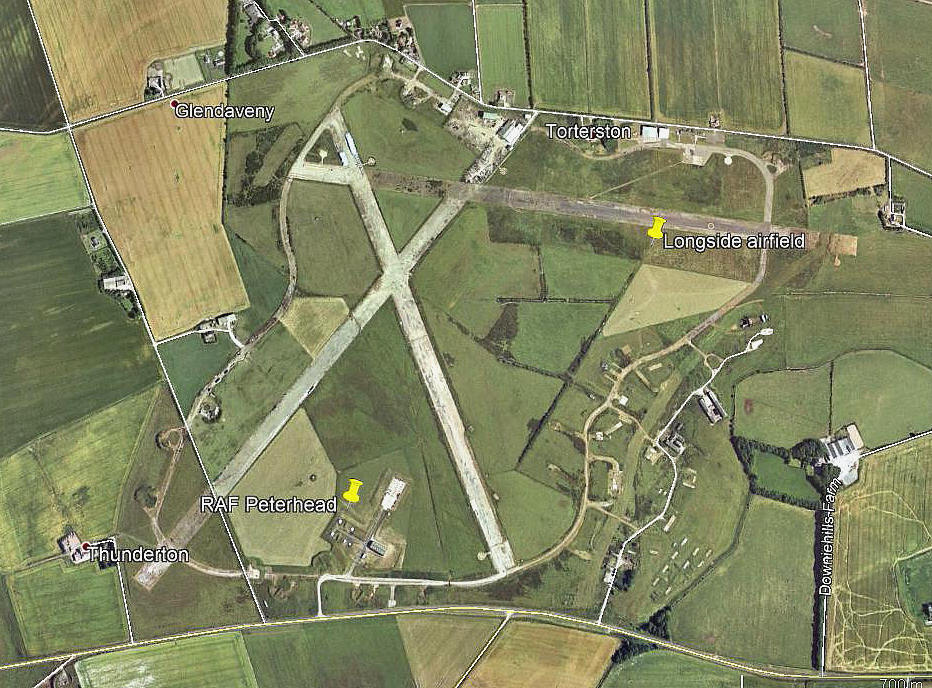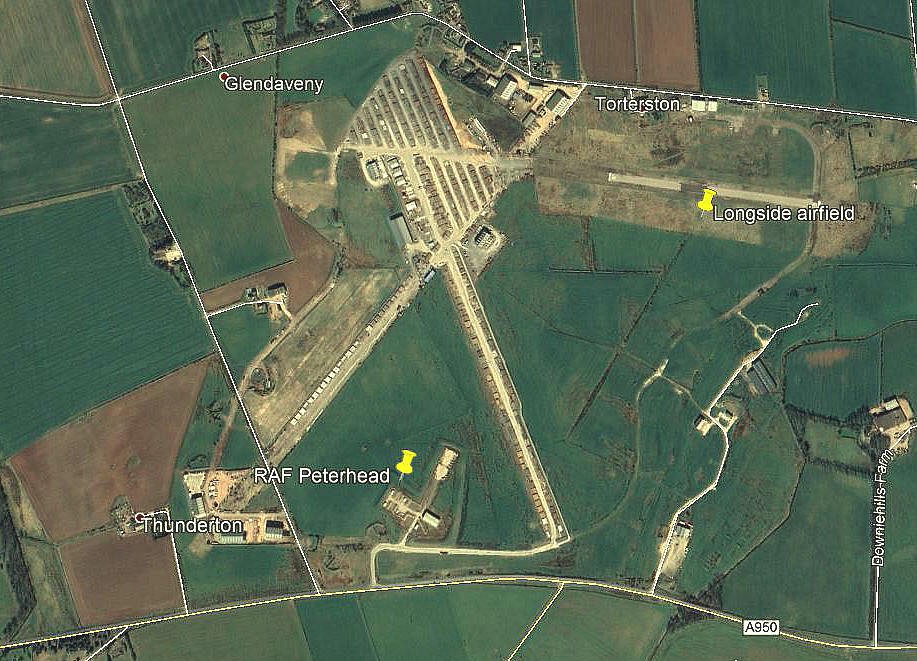Peterhead flying sites
Note: This map is only for the location of the WW2 aerodrome - which I believe is correct. Confirmation will be appreciated.
PETERHEAD: Seaplane Alighting Area
NOTES: Shown on Admiralty chart 1438 in the 1930s. Presumably same as PETERHEAD BAY?
See listing below.
PETERHEAD: Temporary aerodrome?
NOTES: On the 10th May 1934 Sir Alan Cobham’s UK Tour displayed in/near Peterhead. As usual I’ll ask, is the venue location known?
PETERHEAD: Military aerodrome later civil airfield and later still civil heliport
(Originally in WW1 RNAS, later RAF, LONGSIDE - see seperate entry)
(later known as LONGSIDE AIRFIELD - see seperate entry for LONGSIDE GA)
Note: These pictures were obtained from Google Earth ©
Military user: RAF Fighter Command 13 Group
(Forward Airfield - Nightfighter in 1944)
315 (Polish) Sqdn (North American P-51 Mustangs)
411 (RCAF) Sqdn (Vickers-Supermarine Spitfires)
Note: It appears that a detachment of 411 Squadron, based in southern England, were ordered to fly up here from the 24th February until April 1944. The obvious question is - why? It obviously didn't advance the war effort, probably the exact opposite, so who ordered the move, and what agenda were they working to?
602 (City of Glasgow) Sqdn (Vickers-Supermarine Spitfires)
611 (West Lancashire) Sqdn (North American P-51 Mustangs)
70 Group
598 AAC (Anti-Aircraft Cooperation) Sqdn (Airspeed Oxfords)
Civil operator: 1980s to 2000: Bond Helicopters Ltd
Location: N of A950, 3nm W of Peterhead
Period of operation: Military: 1941 to 1945
Civil heliport: 1980s to 2000. GA use from 1985(?) to -
Runways: WW2: 05/23 1372x46 hard 11/29 1340x46 hard
17/35 1620x46 hard
2000: 10/28 610x46 hard
2009: Just a 490m long tarmac strip according to an AAIB report and forming part of a WW2 runway, presumably 11/29?
NOTES: Despite it’s fairly remote position even in late 1944 this station must have still been considered as being fairly important with 1576 RAF and 389 WAAFs based here. The question I’d ask though, having visited this region - is what on earth were they protecting?
From 1985 it appears used for private flying, and indeed in 2019 at least, still is.
PETERHEAD BAY: Military Seaplane Station
Military users: RNAS/RAF Seaplane Station and Seaplane Repair Depot
Location: Just S of Peterhead town centre
Period of operation: 1918 to 1919
Site area (Land): 90 acres
lesley
This comment was written on: 2017-11-19 22:22:58In response to your questions asking why was the airfield there during WW2. My grandfather was based on the airfield during the war. He always told me they were there was to patrol and protect the Royal Navy fleet in Scapa Flow and the Norweigan sea. He was in the Fleet Air Arm and worked as ground crew to repair and maintain aircraft.
Reply from Dick Flute:
Hi Lesley. Many thanks, I shall keep this posted. I have been very interested in the way the military system works and it often does not seem to make a lot of sense. Given several other airfields so much closer and available to offer protection to Scapa Flow and sea areas further north, I was quite surprised to learn this. Best regards, Dick
Kenny
This comment was written on: 2018-12-07 18:54:25RAF Peterhead was important in the sense that it protected the vital sea corridor between the English ports and the entrance to the Atlantic, consequently Peterhead itself was very heavily bombed. Sir Alan Cobham performed at Clerkhill Farm, then well outside the town, now part of it.
Reply from Dick Flute:
Hi Kenny, Many thanks indeed for kindly explaining this. And for providing a 'new' site for Cobham. Best regards, Dick
richard brand
This comment was written on: 2020-05-05 10:10:33Mustangs from here provided fighter cover for mossies and beaufigters of the Banff strike wing, operating from Boyndie/Banff and Dallachy. Circa Mid 1944-May 1945.They were attacking shipping in Norwegian Fjords and off norway. see the book a seperate little war. Private flying still takes place from this site.
We'd love to hear from you, so please scroll down to leave a comment!
Leave a comment ...
Copyright (c) UK Airfield Guide

















